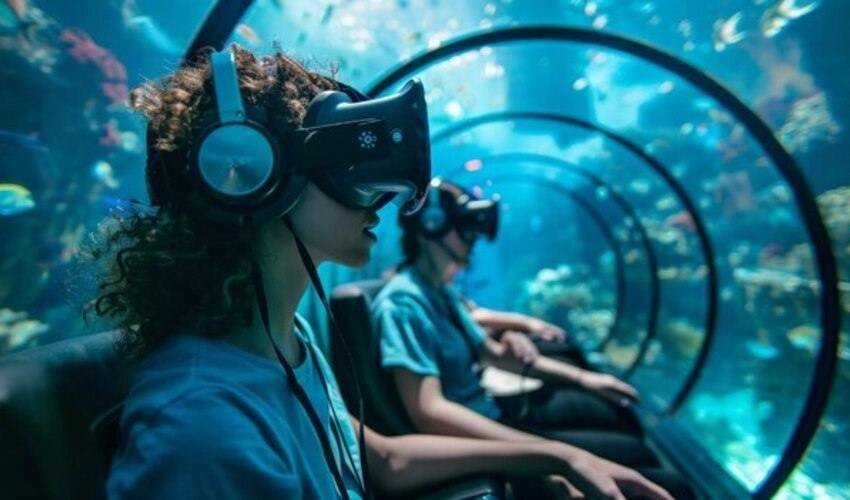Virtual reality (VR) has evolved tremendously in recent years. From simple headsets to complex immersive systems, the world of VR keeps advancing. But there’s a new concept on the horizon that could completely change our experience with virtual worlds: Full Dive VR. This technology promises a deeper and more realistic VR experience, allowing users to immerse themselves fully in digital environments. But what exactly is Full Dive VR? And what does the future hold for this groundbreaking technology?
What is Full Dive VR?
Full Dive VR is a step beyond traditional VR. In standard VR, users interact with virtual environments using controllers and headsets. However, these systems do not directly connect with the brain. Full Dive VR, on the other hand, aims to create a more immersive experience by linking the brain to the virtual world. Imagine being able to feel, see, and even smell everything in a virtual environment as if it were real. Full Dive VR aims to make this possible.
In essence, Full Dive VR works by directly stimulating the brain, bypassing the usual sensory inputs. This would allow users to experience a world that feels as real as the physical one. Whether it’s feeling the wind on your face or tasting the food you’re eating in the game, Full Dive VR could make these experiences much more vivid.
The Technology Behind Full Dive VR
For Full Dive VR to work, it requires advanced technologies that are still being developed. One key component is brain-computer interfaces (BCIs). BCIs allow communication between the brain and external devices. By reading brain signals and sending information back to the brain, BCIs could make a Full Dive VR system possible.
These interfaces would need to be incredibly sophisticated. They must process vast amounts of data in real-time to replicate a convincing virtual environment. For example, if you move your hand in the game, the system must send the right signals to your brain to make it feel like you’re really moving. Likewise, the sensory feedback must match the virtual world precisely. If you touch an object, your brain should perceive the correct texture and temperature.
Another major hurdle for Full Dive VR is safety. Directly interfacing with the brain comes with risks. Scientists are still exploring how to safely stimulate the brain without causing harm. However, as technology advances, these risks may decrease, and safety measures will likely improve.
Benefits of Full Dive VR
The potential benefits of Full Dive VR are immense. In the world of entertainment, Full Dive VR could change how we experience games and movies. Imagine entering your favorite game as if you were part of it. You could walk around, interact with characters, and make decisions based on your surroundings. Unlike current VR systems, which only allow limited interaction, Full Dive VR could make the game feel fully real.
In addition to gaming, Full Dive VR could revolutionize fields like education and training. Students could experience historical events firsthand or explore complex scientific concepts in a fully immersive environment. Surgeons could practice delicate procedures in virtual operating rooms. Engineers could test designs and prototypes without the need for physical models. Full Dive VR could provide a new level of realism that enhances learning and skill development.
Moreover, Full Dive VR could have therapeutic uses. It may help people with phobias by allowing them to face their fears in a safe and controlled environment. It could also be used for rehabilitation, enabling patients to practice physical therapy in a virtual space. This technology could open new doors in mental health treatment and physical recovery.
Challenges in Developing Full Dive VR
While the benefits are clear, Full Dive VR faces significant challenges. One of the biggest obstacles is the hardware. For Full Dive VR to work, we need to develop devices that can interact with the brain effectively and safely. Current VR systems rely on bulky headsets and controllers, but Full Dive VR will likely require new kinds of wearable devices or even implants.
Another challenge is the need for powerful computing. Full Dive VR requires real-time processing of massive amounts of data to create a realistic experience. This means that the devices running Full Dive VR must be incredibly fast and efficient. Today’s computers might not be able to handle this level of processing yet, but advancements in computing power could change that.
There are also ethical concerns. Directly interfacing with the brain raises questions about privacy and security. Hackers could potentially gain access to a person’s thoughts or experiences. Researchers must address these concerns before Full Dive VR can become a mainstream technology.
The Road to Full Dive VR
The development of Full Dive VR is still in its early stages. Many of the necessary technologies, such as advanced BCIs, are not yet fully developed. However, researchers and companies are making progress. Companies like Neuralink, led by Elon Musk, are working on brain-computer interfaces that could be key to making Full Dive VR a reality. The next few years will be crucial in determining how quickly these technologies advance.
In the meantime, we can expect to see improvements in existing VR technology. While Full Dive VR is not yet ready for mass adoption, the foundation for it is being laid today. As we continue to push the boundaries of what VR can do, the dream of Full Dive VR seems increasingly possible.
The Future of Full Dive VR
Looking ahead, Full Dive VR could become a staple of entertainment, education, and more. As the technology becomes more refined, it may change how we connect with one another. Virtual spaces could become as important as physical ones, allowing people to interact in ways that were previously unimaginable.
The potential for Full Dive VR to transform industries is immense. It could redefine how we learn, how we play, and even how we work. As we continue to explore the possibilities, we may find that the future of immersion lies in the world of Full Dive VR.
Conclusion
Full Dive VR is the next frontier in virtual reality. While it may not be ready yet, the research and developments being made today are paving the way for an incredibly immersive future. Whether for gaming, education, or therapy, Full Dive VR has the potential to reshape our world in ways we never thought possible. As technology advances and challenges are overcome, the dream of full immersion in a digital world may soon become a reality.
With each step forward, we are one step closer to experiencing a world where the line between reality and virtuality is blurred, and our senses are fully engaged in a virtual experience. The future of immersion is exciting, and Full Dive VR is leading the way.
Read Dive is a leading technology blog focusing on different domains like Blockchain, AI, Chatbot, Fintech, Health Tech, Software Development and Testing. For guest blogging, please feel free to contact at readdive@gmail.com.





